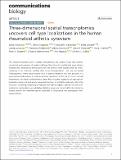Three-dimensional spatial transcriptomics uncovers cell type localizations in the human rheumatoid arthritis synovium
Author(s)
Vickovic, Sanja; Schapiro, Denis; Carlberg, Konstantin; Lötstedt, Britta; Larsson, Ludvig; Hildebrandt, Franziska; Korotkova, Marina; Hensvold, Aase H; Catrina, Anca I; Sorger, Peter K; Malmström, Vivianne; Regev, Aviv; Ståhl, Patrik L; ... Show more Show less
DownloadPublished version (4.932Mb)
Publisher with Creative Commons License
Publisher with Creative Commons License
Creative Commons Attribution
Terms of use
Metadata
Show full item recordAbstract
<jats:title>Abstract</jats:title><jats:p>The inflamed rheumatic joint is a highly heterogeneous and complex tissue with dynamic recruitment and expansion of multiple cell types that interact in multifaceted ways within a localized area. Rheumatoid arthritis synovium has primarily been studied either by immunostaining or by molecular profiling after tissue homogenization. Here, we use Spatial Transcriptomics, where tissue-resident RNA is spatially labeled in situ with barcodes in a transcriptome-wide fashion, to study local tissue interactions at the site of chronic synovial inflammation. We report comprehensive spatial RNA-Seq data coupled to cell type-specific localization patterns at and around organized structures of infiltrating leukocyte cells in the synovium. Combining morphological features and high-throughput spatially resolved transcriptomics may be able to provide higher statistical power and more insights into monitoring disease severity and treatment-specific responses in seropositive and seronegative rheumatoid arthritis.</jats:p>
Date issued
2022Department
Massachusetts Institute of Technology. Department of BiologyJournal
Communications Biology
Publisher
Springer Science and Business Media LLC
Citation
Vickovic, Sanja, Schapiro, Denis, Carlberg, Konstantin, Lötstedt, Britta, Larsson, Ludvig et al. 2022. "Three-dimensional spatial transcriptomics uncovers cell type localizations in the human rheumatoid arthritis synovium." Communications Biology, 5 (1).
Version: Final published version